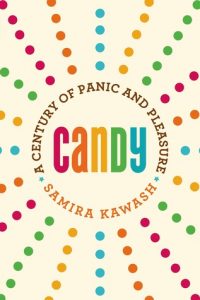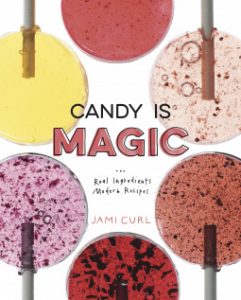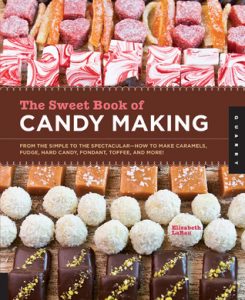 So it’s October, and frightfully close to Halloween (may I interest you in our Halloween Spooktacular?), so I figured I’d cover something topical – Candy: A Century of Panic and Pleasure by Samira Kawash – because whether you celebrate All Hallow’s Eve or not, you’ll likely find it nigh impossible to avoid the sight of candy as the day nears.
So it’s October, and frightfully close to Halloween (may I interest you in our Halloween Spooktacular?), so I figured I’d cover something topical – Candy: A Century of Panic and Pleasure by Samira Kawash – because whether you celebrate All Hallow’s Eve or not, you’ll likely find it nigh impossible to avoid the sight of candy as the day nears.
While I suppose it would be difficult to make any discussion of candy dull and boring, Kawash does an especially wonderful job keeping the writing lively and inserting a dose of her personality in every chapter as she takes us along the history of candy in North America. The incredulity with which she introduces a rather sophistic argument from a party advertising candy as an entirely wholesome and nutritious food will crack you up, and her exasperation at finding so little information about candy in what look to be promising tomes of histories about food in America is palpable. That being the case, though, she makes sure to write in their defence where it’s due, as when pointing out that information about nutrition was woefully incomplete then, which lets the reader have a better understanding of the times and perceptions. Kawash’s tongue-in-cheek attitude while discussing the history of candy is fitting, and the ambiguities she talks about as to what even constitutes candy, and how arguments for and against candy have at points not made much sense or – even worse – built on the exact same “evidence”, is delightful.
Of particular interest to me was that perceptions of candy did complete cartwheels throughout the decades, from being a wholesome and healthful food replete with the nutrients your body needs in order to survive (the argument being that because candy gives you lots of calories at a lower cost than other foods, that it is a good food with which to fuel yourself), to being reviled as carriers of poison – both physical and moral, and regardless of whether there was any evidence to point to when claiming they were physically poisonous. (I wonder whether some of those articles mightn’t be sued for libel today if they ran.)
Kawash also discusses Halloween and how the trick-or-treating tradition we associate with the holiday came to be (read: we’re kind of bribing children to not go about engaging in all sorts of mischief; alternatively, we’re being threatened by the possibility of children wreaking havoc and are thus trying to stop their pranks in advance by giving into their demands*). To my surprise, candy wasn’t always the treat of choice: hand-baked goods and toys were just as likely in the beginning to be handed out as candy. How candy companies took over that entire market is an interesting story, so I won’t spoil your appetite for it here. Just know that this book is fully worth the read!
One of the chapters talks about how many of the earlier recipe books published for the home confectioner often did not stress how difficult it is to get all of the variables just so – as is needed in making candy – using equipment found at home, and included recipes that almost seemed to be geared towards failure for the beginner home confectioner. With that in mind, and not so much to discourage you from trying out your hand at making candy, because I suppose we probably have more precise measuring tools and that there have since been improvements in the understanding of how to make candy (though I don’t know for a fact that we do), but without further ado, I present to you some candy cookbooks for the home confectioner!
 Candy is Magic: Real Ingredients, Modern Recipes by Jami Curl immediately makes me think of how Kawash notes that recipe books encouraging housewives to take up candy-making would stress that home-made was purer and therefore better than store-bought penny candies (not that you can get candies for a penny anymore, mind – especially not now that the penny is defunct). Whether that the case or not
Candy is Magic: Real Ingredients, Modern Recipes by Jami Curl immediately makes me think of how Kawash notes that recipe books encouraging housewives to take up candy-making would stress that home-made was purer and therefore better than store-bought penny candies (not that you can get candies for a penny anymore, mind – especially not now that the penny is defunct). Whether that the case or not
You’ll find over 200 recipes from lollipops and marshmallows in this candy recipe book, and you don’t even need any special equipment to make them!
 There’s also The Sweet Book of Candy Making by Elizabeth LaBau, which promises troubleshooting tips and after following which you should be able to perfect the classic candies, from fudge to peanut brittle and more! Certainly the variety of candies on the cover are rather tantalizing, and there is a variety of over 50 recipes for different candies in this recipe book.
There’s also The Sweet Book of Candy Making by Elizabeth LaBau, which promises troubleshooting tips and after following which you should be able to perfect the classic candies, from fudge to peanut brittle and more! Certainly the variety of candies on the cover are rather tantalizing, and there is a variety of over 50 recipes for different candies in this recipe book.
And if that’s not quite enough, we also have a number of other candy recipe books such as The Liddabit Sweets Candy Cookbook and Hand-Crafted Candy Bars, as well Theo Chocolate. And a quick search through the catalogue will turn up over 30 items for your perusal with regards to candies and chocolates!
*I don’t know how I feel about this wholesale bribery, especially considering how I remember most of my cohort not even having any pranks at the ready if anyone were ever to actually say they’d prefer a trick over giving us a treat. What are we teaching children?